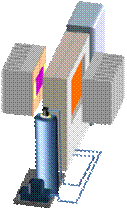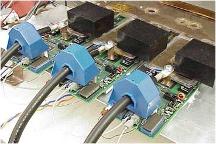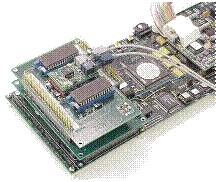

|
Depending on the heat source and application we can identify several types of TPV systems: · portable power generation (gaseous or liquid fuel depending on application), · residential cogenerated heat and electricity (any type of liquid or gaseous fuel), · radioisotope power systems for flagship deep space exploration missions (radioisotope source), · industrial heat regeneration (waste heat form industrial processes), and · solar-thermophotovoltaic power generators (solar radiation). The goal of this project is to demonstrate a 20 W portable multi-fuel (or should I say almost any fuel) thermophotovoltaic electrical power generator, for applications in portable power generation (for consumer electronics (laptops, cell-phones etc.), remote sensing, as an electricity source in remote and undeveloped regions and further). With energy density of 400 Wh/kg, which is more than 2.5 times higher than the best Li-ion batteries today, our system would for the same amount of electric energy stored as a battery will be 2.5 times lighter. |
|
We have been working on a new and universal architecture and digital control software and hardware that will establish an easy to use, universal set of tools for power electronics system desgners. This new approach provides a unified control hardware and software environment that can be used to design, simulate and control power electronics converters from watts to megawatts range, using same software environment, same control hardware, and same familiar graphic user interface.
The idea is to provide an easy to use set of tools for engineers so they can design power electronics for large spectrum of application, even without being power electronics specialist. And if you are power electronics specialist, you would use the same set of tools dramatically cutting down the development time. Lets say you want to design a photovoltaic generation system connected to a grid.. You can use the same simulation environment you always use, you can use one of the standardized digital controllers (customized for power electronics requirements) and you can design, test and implement your final digital design with a push of a button.
We are all very familiar with this concept, as it has been the main driving force behind the microelectronics revolution. We all love to use standardized chips or microcontrollers and just interconnect them in a straightforward fashion without the need to understand the intricate physics of semiconductors. And we all use software tools to simulate, emulate, configure and build microelectronics systems once interconnected together. Well, the same reality is inevitable in power electronics systems and in wider energy conversion realm. |
|
The ability of photonic crystals to tailor thermal radiation and modify spontaneous emission is opening immense possibilities for new energy conversion devices, sensors, detectors, infra-red radiation sources and further. Indeed, photonic crystals offer unparalleled possibilities for designing thermal radiation sources with properties that are often non-intuitive and deviate significantly from those of typical grey-body sources. Our research focuses on two aspects of photonic crystals thermal radiation “shaping” devices, namely: broad-band and narrow-band thermal radiation sources and filters. Photonic crystals for broad-band thermal radiation shaping We have extensively studied one-dimensional and two-dimensional photonic crystals as selective, broadband, optical filters/mirrors and thermal emitters. We have shown that photonic crystals provide a wonderful framework for broadband shaping, filtering and generating thermal radiation. One of the most exciting applications for photonic crystals as broad-band thermal radiation shaping devices are low-temperature, high-efficiency thermophotovoltaic systems. Indeed, the ability to tailor simultaneously photonic bandgap in PhC’s and electronic bandgap in low-bandgap III-V semiconductor materials (e.g. GaInAsSb) enabled record breaking TPV efficiencies. Resonant thermal emission Our group has been studying the phenomenon of resonant thermal emission in photonic crystal materials for quiet some time. We have invented and designed a couple of PhC’s that exhibit narrow band, highly directional, partially coherent, tunable thermal emission. This is completely counterintuitive to conventional understanding of blackbody radiation or grey body radiation. In addition, we have discovered several highly anomalous radiation phenomena arising from the reach physics of photonic crystals
|
|
Project Taconics Portable thermophotovoltaic power Generator |
|
Project Typhoon Unified digital control platform for power electronics systems |
|
Photonic Crystals: shaping the flow of thermal radiation |
|
Projects |

|
Devices that statically convert heat into electricity—without moving parts—have been the subject of human curiosity for nearly two centuries. However, low efficiency and high costs have hindered widespread and large scale acceptance of many static energy conversion devices and systems. Our mission is to change this notion and to demonstrate that viable, high-performance and low-cost static energy generation devices and systems are practical. One of the examples of a static energy conversion system that we have been working on are Thermophotovoltaics (TPV).
Thermophotovoltaics (TPV) is a static power conversion system that converts radiant heat into electricity by means of photovoltaic cell. Thermal energy is first converted into radiant heat or photons by means of thermal emitter and then photons are converted into electricity in a photovoltaic diode. |
|
Fig. 1 Diagram of 20 W thermophotovoltaic power generator |
|
Main advantages to of a TPV portable power generator are: static energy generation (meaning virtually noise and vibration free), multi-fuel operation, ruggedness, and possibility for additional heat and/or cooling generation. When you combine these features with latest advances in photonics and low-bandgap semiconductor materials which have enabled high TPV conversion efficiencies, you get a wonderful power generation technology such as TPV. |

|
Fig. 2 Engineering prototype of the MIT 20 W thermophotovoltaic portable power generator nicknamed Taconics. |
|
The need for low-cost, high-reliability, easy-to-use power electronics systems is becoming more and more pronounced. Long design cycles, complex maintenance, lack of standardization and high costs are slowing down possibilities for wider proliferation of power electronics converters. Power electronics has reached the point where further advancement, in terms of wider application of converters can hardly be achieved unless the community is presented with easy to use, of-the-shelf, standardized and flexible power electronics modules. And in this day and age, where nearly every possible electrical system in the world needs some kind of power electronics ,either to increase conversion efficiency or enhance system performance, the need for tools that will enable wider community of developers to take advantage of possibilities power electronics systems offer has never been more pressing.
|




|
Ivan Celanovic |

